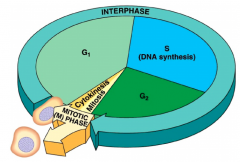![]()
![]()
![]()
Use LEFT and RIGHT arrow keys to navigate between flashcards;
Use UP and DOWN arrow keys to flip the card;
H to show hint;
A reads text to speech;
38 Cards in this Set
- Front
- Back
|
Where do cells come from?
|
Cells come from other cells through cell division.
|
|
|
Why do cells divide?
|
1) Repair
2) Growth 3) Reproduction |
|
|
What's the only reason single-celled organisms divide?
|
For reproduction.
|
|
|
Cell division in prokaryotes (Bacteria)
|
Single-celled organisms.
Have one CIRCULAR chromosome. --copied by DNA replication |
|
|
How do cells divide?
|
Binary Fission.
--Not mitosis or meiosis. --Cells always divide with adequate nutrients. --Chromosomes are anchored to the cell membrane. |
|
|
Why is eukaryotic cell division more complicated?
|
1) Membrane-bound organelles
--mitochondira, chloroplasts (divide themselves) --ER, golgi (disintegrates) 2) Multiple chromosomes |
|
|
What are the two types of cell division in eukaryotes?
|
Meiosis, Mitosis.
|
|
|
Mitosis V.S. Meiosis
|
Mitosis: Produces daughter cells that are identical to the parent. For growth, repair/regeneration.
Meiosis: Produces daughter cells with 1/2 the number of chromosomes. For reproduction. |
|
|
Where does Mitosis occur?
|
Body cells = somatic cells.
Not egg cells or sperm cells. |
|
|
When does mitosis occur?
|
At the end of the cell cycle.
|
|
|
The Cell Cycle
|

A tightly regulated series of events, unique to eukaryotes.
Cell division occurs during the "M phase". The rest of the cycle is Interphase. --Between cell division --90% of the process Among the most intensely studied processes. |
|
|
What is this process controlled by?
|
Many enzymes.
|
|
|
Interphase has 3 subphases:
|
S phase
--Chromosome duplication --DNA synthesis (replication) Two gap phases: G1, G2. --Separate M and S --G1: Special growth. Prep for S phase. Biggest phase --G2: Slightly more growth. Prep for M phase. |
|
|
M phase has two parts:
|
Mitosis
--Division of the nucleus. Cytokinesis --Division of the cytoplasm. |
|
|
G0 Phase
|
Cells can LEAVE the cell cycle, and enter a non-dividing state. The best time to go into G0 is at the end of G1.
|
|
|
Why is the nuclear DNA carefully inspected in both gap phases?
|
For damage. Damaged Cells -> Mutations-> Cancer.
|
|
|
How often do cells 'cycle'?
|
This depends upon the type of cell.
|
|
|
Three Frequencies of Mitosis
|
1) Continuous (GI Tract)
2) Based on need (Liver) 3) Rare/never (neurons/muscle cells) |
|
|
When can G0 occur in these frequencies?
|
Only in 2 (need), and 3 (rare/never). Only 2 can re-enter.
|
|
|
What are most human cells in?
|
G0.
|
|
|
During the cell cycle, how can genetic material become more or less compact?
|
Nuclear DNA is wrapped around protein, this complex material is called chromatin.
|
|
|
Why is chromatin wrapped around protein?
|
It helps it regulate/organize.
|
|
|
How much DNA does one human cell contain?
|
About 6 feet.
|
|
|
During the M phase, the DNA is...
|
Tightly packed, this allows individual chromosomes become visible.
|
|
|
Chromosomes (in eukaryotic cells)
|
One DNA molecule PLUS the associated proteins.
-- A long linear DNA molecule --Contains 100s, 1000s of genes. |
|
|
Each eukaryotic species has a specific number of chromosomes, human cells have...
|
46.
|
|
|
Chromatid
|
A replicated chromosome are 2 DNA (two sister chromatid) that went through the S phase. One DNA molecule is called a chromatid. The sister chromatids are identical.
|
|
|
Centromere
|
Where the sister chromatids are held together. After cell division, they disappear.
|
|
|
A nucleus typically contains...
|
A chromatin.
|
|
|
Mitosis' 5 stages
|
1) Prophase
2) Prometaphase 3) Metaphase 4) Anaphase 5) Telophase |
|
|
Mitotic spindle
|
Begins to form in the cytoplasm during prophase. Consists of fibers made of microtubules and proteins.
|
|
|
Centrosome
|
The assemble of spindle microtubules start in the centrosome. The centrosome is referred to as the microtubule-organizing center.
|
|
|
Kinetochore
|
The kinetochore is the protein structure on chromatids where the spindle fibers attach during cell division to pull two sister chromatids apart.
|
|
|
Prophase
|
The chromatin condenses into chromosomes in which the chromatin becomes visible.
|
|
|
Prometaphase
|
The nuclear membrane dissolves. Proteins attach to the centromeres creating the kinetochores. Microtubules attach at the kinetochores and the chromosomes begin moving.
|
|
|
Metaphase
|
The centrosomes are at opposite poles of the cell. The chromosomes, now at their most highly coiled and condensed, convene at the metaphase plate. Each chromosome is attached to a kinetochore microtubule.
|
|
|
Anaphase
|
Shortest stage. Sister chromatids separate, become a chromosome, move to opposite poles.
|
|
|
Telophase
|
Two daughter nuclei form in the cell. Chromosomes decondense. Spindle microtubules depolymerize.
|

